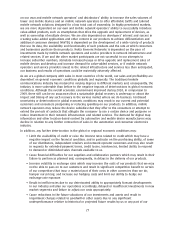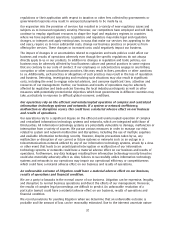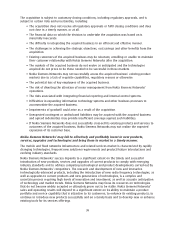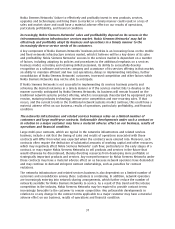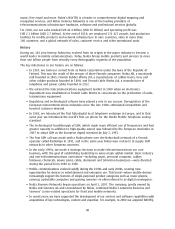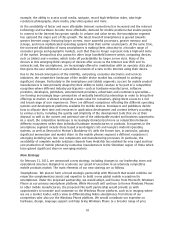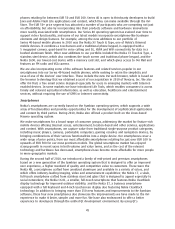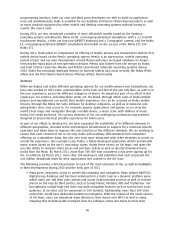Nokia 2010 Annual Report Download - page 38
Download and view the complete annual report
Please find page 38 of the 2010 Nokia annual report below. You can navigate through the pages in the report by either clicking on the pages listed below, or by using the keyword search tool below to find specific information within the annual report.Nokia Siemens Networks’ failure to effectively and profitably invest in new products, services,
upgrades and technologies and bring them to market in a timely manner could result in a loss of
sales and market share and could have a material adverse effect on our results of operations,
particularly profitability, and financial condition.
Increasingly, Nokia Siemens Networks’ sales and profitability depend on its success in the
telecommunications infrastructure services market. Nokia Siemens Networks’ may fail to
effectively and profitably adapt its business and operations in a timely manner to the
increasingly diverse service needs of its customers.
A key component of Nokia Siemens Networks’ business priorities is an increasing focus on the mobile
and fixed networks infrastructure services market, which it believes will be a key driver of its sales
and profitability. Nokia Siemens Networks’ success in the services market is dependent on a number
of factors, including adapting its policies and procedures to the additional emphasis on a services
business model, recruiting and retaining skilled personnel, its ability to successfully develop
recognition as a software and services company and acceptance of its services offering in that market,
an ability to maintain efficient and low cost operations, delays in implementing initiatives, further
consolidation of Nokia Siemens Networks’ customers, increased competition and other factors which
Nokia Siemens Networks may not be able to anticipate.
If Nokia Siemens Networks is not successful in implementing its services business priority and
achieving the desired outcomes in a timely manner or if the services market fails to develop in the
manner currently anticipated by Nokia Siemens Networks, its business will remain focused on the
traditional network systems product offering, which is increasingly characterized by equipment price
erosion, maturing industry technology, intense price competition and nonrecurring sales. If that
occurs, and the current trends in the traditional network systems market continue, this could have a
material adverse effect on our business, results of operations, particularly profitability, and financial
condition.
The networks infrastructure and related services business relies on a limited number of
customers and large multiyear contracts. Unfavorable developments under such a contract or
in relation to a major customer may have a material adverse effect on our business, results of
operations and financial condition.
Large multiyear contracts, which are typical in the networks infrastructure and related services
business, include a risk that the timing of sales and results of operations associated with those
contracts will differ from what was expected when the contracts were entered into. Moreover, such
contracts often require the dedication of substantial amounts of working capital and other resources,
which may negatively affect Nokia Siemens Networks’ cash flow, particularly in the early stages of a
contract, or may require Nokia Siemens Networks to sell products and services in the future that
would otherwise be discontinued, thereby diverting resources from developing more profitable or
strategically important products and services. Any nonperformance by Nokia Siemens Networks under
those contracts may have a material adverse effect on us because network operators have demanded
and may continue to demand stringent contract undertakings, such as penalties for contract
violations.
The networks infrastructure and related services business is also dependent on a limited number of
customers and consolidation among those customers is continuing. In addition, network operators
are increasingly entering into network sharing arrangements, which further reduce the number of
networks available for Nokia Siemens Networks to service. As a result of this trend and the intense
competition in the industry, Nokia Siemens Networks may be required to provide contract terms
increasingly favorable to the customer to remain competitive. Any unfavorable developments in
relation to or any change in the contract terms applicable to a major customer may have a material
adverse effect on our business, results of operations and financial condition.
37


